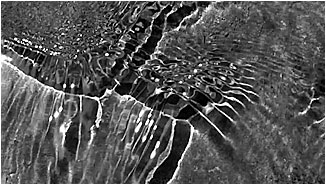
Topic: Analogue Photography
B: You describe yourself as a painter. Are your photographs to be understood as paintings?
K: In my work the photographic image is the final product of a process-oriented image generation and rather related to painting than to the medium of photography.
B: So this photographic final product represent the process or the ritual that precedes these results?
K: The purpose of a documentation is met at most with a Video. The semiotics of my photographic work refers rather to a time-specific structure that is charted by the medium of photography.
The images of the Flux series represent the value of exactly 1/15000 second. While the images of the series Peyotl represent exactly one minute. The images describe different time-spaces. They are a reference to the basic question of time-shrinking and -expansion.
B: The Flux series stick out as a photographic work. You work without camera directly to analogue sheet film. What relevance comes to analogue photography?
K: I am fascinated by the idea of creating a reference to the present by analogue photography, a medium in its last breath. And particularly as it is implemented in a way that digital technology does not reach yet. I am fascinated also in dealing with positive and negative as a correlation to the contemporary, to hidden and obvious reality.
B: Working without a camera is to be understood also in this context?
K: I was looking for the most consistent way to develop a pure language, not influenced by technical apparatuses, but one that corresponds to the notion of a time-specific "extraction". "Extraction" was the notion of a sample, a pattern or symbol of a time trace.
B: And the photomechanic implementation of this idea succeeded right away?
K: The concept initially resulted in images with a somewhat orderly tangle of lines. My interest was rather focused on the intensity of the night action and how my perception changes in the dark than on the picture or the aesthetic aspects of the final result.
B: Night forms a meaningful background?
K: Substantively, darkness is the starting point for "transitions". Transitions are transformation axes where the volatile manifests itself, and time reveals itself as a pictorial space. Darkness is also the condition which lifts us to an instinctive level.
B: What essence of this instinct-level manifests itself in the final image?
K: The instinct-level is the interface between the function of the transmitter (water) and the receiver (me/footage).
Let me explain it with an example of this reciprocal effect between medium and receiver:
For a scientific publication about my work I had to provide technical facts. Since I had previously worked exclusively by feeling, I had to now verify each step of this night action by precise measurements. Focused on data such as incident angle, distance from the film, etc., I have spent several nights without confirmatory results. For the resulting blank films I could not find any photo-technical explanation. In a renewed attempt, a picture was obtained which was very uncharacteristic for water.
I try to explain thereby, that my attitude, my role in the interaction between sender and receiver determines the picture with an appalling obviousness.
B: That sounds pretty esoteric...
K: The (preliminary) unexplained, the non-linear, is unfortunately also one of the many reasons why science is still confused on the subject of water.
B: You have participated in a scientific event on water. What scientific importance has been attributed to your work?
K: My work has been regarded as an evidence for waters quantum coherence. Due to my artistic, low-tech and solely conceptual approach in capturing water, my work differs tremendously from the scientific (laboratory) work. All importance was paid to my technical solutions. Unfortunately, this interest created very unpleasant traits. My speech dealt with exclusively art-related issues - which in turn was met with unease.
B: Would you mind letting us glimpse into your technical solutions?
K: I'm always asked about the technique.
During the beginning of the Flux series I was still teaching photography. Technology was a major focus - not only by the educational program. Amongst the students prevailed the general belief that a good camera would take good pictures. This esteem contrasted with my conviction that makes the concept of seeing and exploring responsible for good pictures. At the time I let myself be carried away by the statement, that it should be possible to imagine and capture the inner structure of water without using a camera at all.
Instead of commenting on the technique I prefer to speak of an attitude. As mentioned, I followed the conceptual objective to capture a time-particle. The capturing, or rather the reception should come very close to a cultic act, as receiving a communion wafer.
B: And your capturing succeeded.
K: Yes. Not that I care to prove that statement. It is more about the submissiveness of the image producer who obediently follows the colourful digital world which is set in front of him by the industry. And that his imagination is wasted.
B: Imagination was the topic of your speech in London; emanating from the accelerated flood of data (and images), you followed the question of whether imagination is a concept of seeing.
K: The revelation of a new way of seeing has an impact on the own imagination, which is irreversible. By the example of the water pictures, the idea of a bulky, transparent liquid can no longer be maintained. The new notion of water as a body, allows more extensive visions of water, which would not be accessible without this visual experience. The concept of penetrating with photosensitive material directly into an otherwise indiscernible space – to catch a picture inside of the quasi-seeing eye – was the imagination, the vision, that now actually manifests itself as a new way of seeing; the understanding of water as a body.
